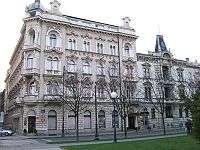Julio Deutsch
| Julio Deutsch | |
|---|---|
.jpg) | |
| Born |
29 September 1859[1] Geppersdorf (now Kopřivná), Austro-Hungarian Monarchy, (now Czech Republic) |
| Died |
9 June 1922 (aged 62)[1] Zagreb, Kingdom of Yugoslavia, (now Croatia) |
| Nationality | Croat |
Julio Deutsch (Croatian: Julije Dajč; born September 29, 1859, died June 9, 1922) was a Croatian architect known for his architectural art nouveau style.[2]
Early life and family
Deutsch was born in Geppersdorf, near Opava, in te Austro-Hungarian Monarchy to a Jewish family.[3][4][5]
Education and later years
He studied at the Vienna University of Technology under Heinrich von Ferstel and Karl König. Deutsch graduated in 1882 and afterwards he moved to Paris to obtain additional practice. In 1888 he moved to Zagreb.
With the recommendation of Hermann Helmer he started his work in the studio of Kune Waidmann. Deutsch made a partnership with Leo Hönigsberg in 1889.[6] Hönigsberg & Deutsch architecture studio was a leading architecture studio in Zagreb at the turn of 19th and 20th centuries. The studio had many associates, including several leading architects of the early 20th century like Vjekoslav Bastl, Otto Goldscheider and Ivan Štefan.
After the death of Leo Hönigsberg, in 1911, the studio was taken over by Deutsch. In 1922 Deutsch died and the studio was inherited by his son, Pavao Deutsch. His son joined with architect Alexander Freudenreich to found Freudenreich & Deutsch architecture studio.[7] Deutsch was buried at the Mirogoj Cemetery.[8]

See also
References
- 1 2 "Grobno mjesto Julia Deutscha - Ž-3-I-102" (in Croatian). www.gradskagroblja.hr. Retrieved 2012-06-13.
- ↑ "Shopping centar u Paromlinu, hotel u tvornici Dimić?". www.jutarnji.hr (in Croatian). Jutarnji list.
- ↑ Snješka Knežević (2011, p. 176)
- ↑ Ognjen Kraus (1998, p. 136)
- ↑ "Židovi u Zagrebu- doprinos". www.cendo.hr (in Croatian). Istraživački i dokumentacijski centar CENDO.
- ↑ "Što bi Zagreb bio bez Židova: Oni su gradu dali vodovod, tramvaj i '505 s crtom'" (in Croatian). Jutarnji list.
- ↑ "Zagrebačka sinagoga" (PDF) (in Croatian). Institut za povijest umjetnosti.
- ↑ (Croatian) Gradska groblja Zagreb: Julio Deutsch, Mirogoj Ž-3-I-102